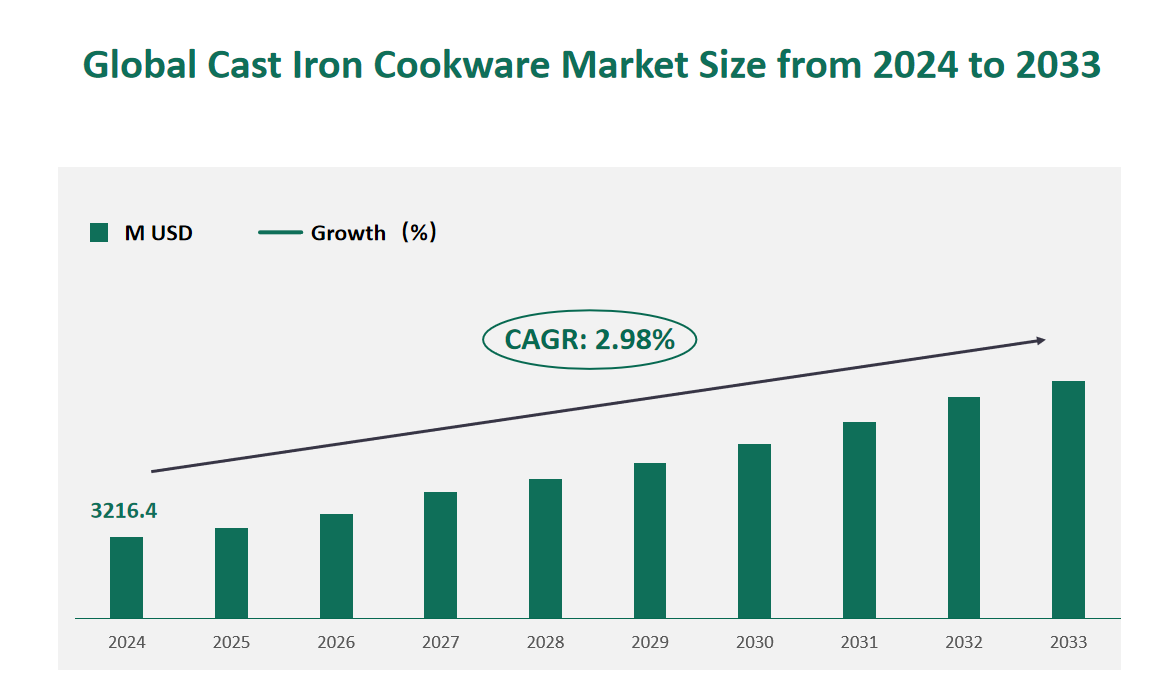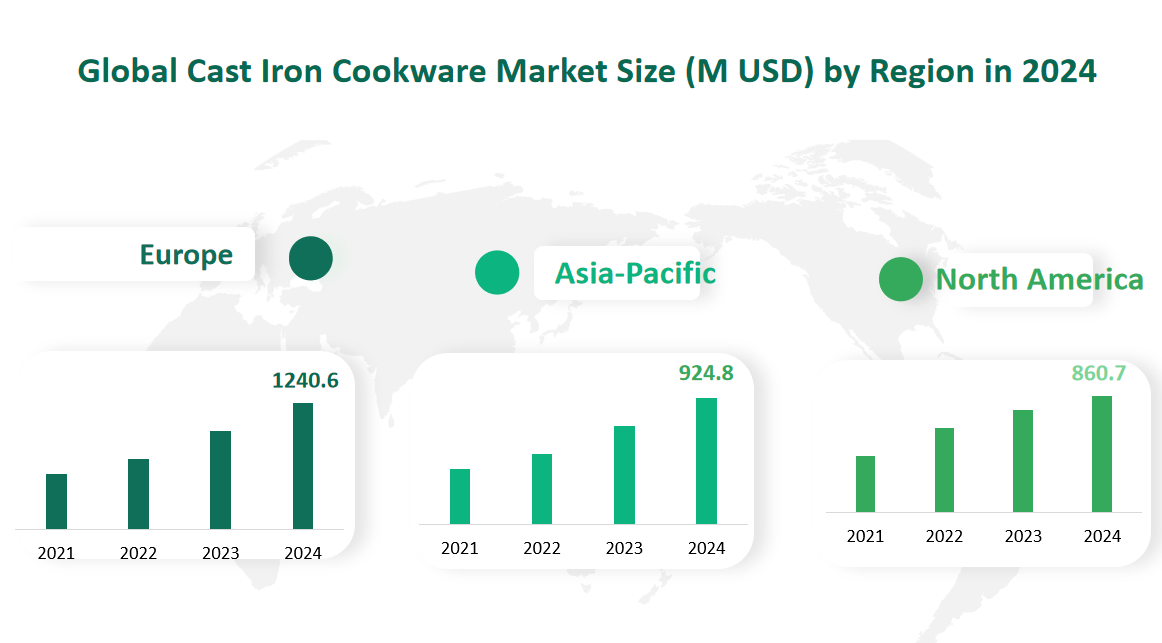1 Global Cast Iron Cookware Market Size (Value) and CAGR (2024-2033)
In 2024, the global Cast Iron Cookware market was valued at USD 3216.4 million, with a CAGR of 2.98% from 2024 to 2033.
Cast Iron Cookware, known for its exceptional heat retention and durability, is crafted from cast iron, a material renowned for its ability to withstand high temperatures and distribute heat evenly. This characteristic makes it an ideal choice for a wide range of cooking methods, from slow simmering to high-heat searing. The cookware’s natural non-stick surface, when properly seasoned, further enhances its appeal, offering a healthier alternative to traditional non-stick coatings that may degrade over time.
Figure Global Cast Iron Cookware Market Size (M USD) and CAGR 2024-2033

2 Cast Iron Cookware Market Drivers and Industry Trends
The Cast Iron Cookware market is experiencing a surge in demand, driven by several key factors and industry trends that are shaping its growth trajectory. One of the primary drivers is the excellent heating performance of cast iron cookware. This type of cookware is known for its high heat retention and even heat distribution, making it ideal for various cooking methods. Its ability to cook food evenly and retain heat for extended periods is particularly beneficial for slow-cooking recipes and maintaining food temperature, which enhances the overall cooking experience and food quality.
Another significant driver is the growing consumer awareness of the health benefits associated with cast iron cookware. Unlike non-stick coatings that can degrade over time, cast iron is a natural and chemical-free alternative. It can also add trace amounts of iron to the food during the cooking process, which is beneficial for individuals with iron deficiencies. This health-conscious shift among consumers is driving the demand for cast iron cookware as a healthier and more sustainable option.
Industry trends also indicate a notable shift towards online sales. The rise of e-commerce platforms has made it easier for consumers to purchase cast iron cookware directly from manufacturers or through online retailers. This convenience factor, coupled with the ability to compare prices and read reviews easily, has significantly boosted the market’s reach and accessibility. The online retail segment is expected to witness substantial growth in the coming years, further expanding the market’s consumer base.
3 Cast Iron Cookware Market Challenges and Restraints
Despite its numerous advantages, the Cast Iron Cookware market faces several challenges and restraints that could potentially hinder its growth. One of the primary challenges is the competition from substitute materials. The market is flooded with alternatives such as aluminum, stainless steel, copper, and non-stick cookware, each offering its unique benefits. For instance, aluminum cookware is lightweight and has a non-stick surface, while stainless steel is non-reactive and highly durable. These alternatives often come at a lower cost, making them an attractive option for price-conscious consumers, thus posing a significant challenge to the cast iron cookware market.
Another restraint is the fluctuations in raw material prices. Cast iron cookware production relies heavily on pig iron and scrap steel, the prices of which can be volatile due to factors such as global supply and demand dynamics, changes in regulations, and geopolitical events. These price fluctuations can lead to increased production costs, which manufacturers may struggle to pass on to consumers without affecting their competitiveness in the market. This cost pressure can squeeze profit margins and limit the ability of manufacturers to invest in innovation and marketing.
4 Global Cast Iron Cookware Market Size by Type in 2024
Dutch Ovens are one of the most popular types of cast iron cookware, known for their versatility and ability to retain heat effectively. These ovens are typically large, lidded pots that can be used for baking, braising, and slow cooking. In 2024, Dutch Ovens are expected to generate a revenue of 667.7 million USD. Their heavy-duty construction and enamel coating make them suitable for both oven and stovetop use, appealing to a wide range of consumers from home cooks to professional chefs.
Skillets/Fryers are another significant category, characterized by their flat bottoms and low sides, ideal for frying, sautéing, and searing. These pans are designed for quick cooking methods and are often used for making pancakes, eggs, and stir-fries. The revenue from Skillets/Fryers is projected to reach 782.4 million USD in 2024. Their ease of use and versatility make them a staple in many kitchens, contributing to their substantial market share.
Woks are traditional Asian cooking vessels with a round bottom and high, sloping sides, perfect for stir-frying, deep-frying, and braising. Woks are gaining popularity globally due to the increasing interest in Asian cuisine. In 2024, the revenue from Woks is expected to be 562.5 million USD. Their unique shape allows for efficient heat distribution and quick cooking, making them a favorite among both professional and amateur cooks.
Griddles are flat, wide pans used for grilling, frying, and making pancakes. They provide a large cooking surface and are often used for cooking multiple items simultaneously. The revenue from Griddles is anticipated to be 440.5 million USD in 2024. Their ability to cook food evenly and retain flavors makes them a popular choice for breakfast and grill enthusiasts.
Bake Ware includes a variety of cast iron baking dishes, such as baking dishes and pie plates. These items are designed for oven use and are known for their ability to distribute heat evenly, ensuring that baked goods cook thoroughly and evenly. The revenue from Bake Ware is projected to reach 323.6 million USD in 2024. Their durability and heat retention make them ideal for both professional bakers and home cooks.
Table Global Cast Iron Cookware Market Size by Type in 2024
Type | Market Size (M USD) 2024 | Market Share 2024 |
Dutch Ovens | 667.7 | 20.76% |
Camp Pots | 211.2 | 6.57% |
Skillets/ Fryers | 782.4 | 24.33% |
Woks | 562.5 | 17.49% |
Griddles | 440.5 | 13.69% |
Bake Ware | 323.6 | 10.06% |
Other | 228.5 | 7.10% |
5 Global Cast Iron Cookware Market Size by Application in 2024
Household applications are the primary segment, driven by the increasing popularity of home cooking and the growing awareness of the health benefits of cast iron cookware. Consumers are increasingly opting for cast iron due to its ability to enhance the nutritional value of food by adding iron and its excellent heat retention properties. In 2024, the revenue from the Household application is expected to reach 1293.4 million USD. This segment includes a wide range of products such as skillets, Dutch ovens, and griddles, which are used for various cooking methods like frying, baking, and slow cooking.
Food Services is another significant application area, encompassing restaurants, hotels, and catering services. The professional use of cast iron cookware is valued for its durability and ability to withstand high-temperature cooking environments. It is particularly favored for its consistent heat distribution, which is crucial for maintaining the quality and taste of food in commercial kitchens. The revenue from the Food Services application is projected to be 1923 million USD in 2024. This segment’s growth is fueled by the expanding restaurant industry and the increasing demand for high-quality cooking equipment that can handle large volumes of food preparation.
Table Global Cast Iron Cookware Market Size by Application in 2024
Application | Market Size (M USD) 2024 | Market Share 2024 |
Household | 1293.4 | 40.21% |
Food Services | 1923.0 | 59.79% |
6 Global Cast Iron Cookware Market Size by Region in 2024
North America is a significant market, driven by the high demand for durable and versatile cookware. The region’s consumers are increasingly health-conscious and prefer cookware that enhances the nutritional value of their meals. In 2024, North America is projected to contribute 860.7 million USD to the global market. The United States, in particular, is a major market within the region, with a strong presence of both local and international brands.
Europe is another key region, known for its rich culinary traditions and appreciation for high-quality cookware. European consumers value the heat retention and even heat distribution of cast iron cookware, making it a popular choice for both home cooking and professional kitchens. In 2024, Europe is expected to generate a revenue of 1240.6 million USD. Countries like Germany, France, and Italy have a significant market presence, with a strong preference for cast iron products in both household and food service applications.
Asia-Pacific is a rapidly growing region, driven by the increasing middle-class population and rising consumer spending power. The region’s consumers are becoming more aware of the health benefits of cast iron cookware and are adopting it for their cooking needs. In 2024, the Asia-Pacific market is projected to contribute 924.8 million USD to the global revenue. China and Japan are major markets within the region, with a growing demand for cast iron products due to their versatility and durability.
Figure Global Cast Iron Cookware Market Size by Region in 2024

7 Major Players in Global Cast Iron Cookware Market
7.1 Le Creuset
Le Creuset is a renowned French company that has been producing high-quality cast iron cookware since 1925. The company is famous for its enameled cast iron cookware, which is not only functional but also aesthetically pleasing.
Le Creuset’s products are known for their excellent heat retention, durability, and versatility, making them suitable for various cooking methods. The company’s product range includes Dutch ovens, skillets, griddles, and a variety of other cookware items.
In the most recent year, Le Creuset reported a revenue of 385.0 million USD and a gross margin of 19.94%.
7.2 Groupe SEB
Groupe SEB is a leading global player in the small domestic appliances and cookware market, with a history dating back to 1857. The company operates under several well-known brands, including Tefal, Rowenta, and WMF, among others. Groupe SEB’s cast iron cookware is recognized for its innovation and reliability, catering to both professional chefs and home cooks. The company’s extensive product range includes a variety of cast iron pots, pans, and ovens, designed to meet diverse cooking needs.
In the most recent year, Groupe SEB achieved a revenue of 206.1 million USD from its cast iron cookware segment, with a gross margin of 20.64%.
7.3 Meyer
Meyer is a prominent Australian company that has been manufacturing cookware since 1951. Meyer’s cast iron cookware is known for its excellent heat distribution and durability, making it a popular choice among consumers. The company offers a wide range of products, including skillets, Dutch ovens, and griddles, which are designed to enhance the cooking experience and provide consistent results. Meyer’s commitment to quality and innovation has helped it establish a strong presence in markets across Asia, Europe, and North America.
In the most recent year, Meyer reported a revenue of 156.9 million USD from its cast iron cookware business, with a gross margin of 22.27%.

